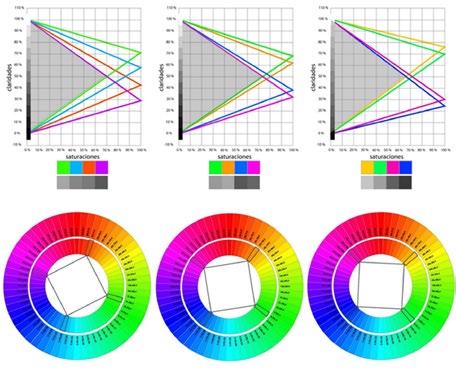Proposal of a model for colored lights, precise, digitizer and useful for design. Returning to Munsell.
##plugins.themes.bootstrap3.article.main##
Abstract
Since 1905, Albert Munsell has unveiled a conceptually precise color pigment model called "tree of color". As of 1931, various color models for lights have been created, to be digitized, in which attempts have been made to reach the accuracy of the "tree", without success. This work investigates the causes that cause the imprecision of the current models for light colors, with a view to propose a model, digitized, precise and useful to the Design, with the Munsell as a paradigm.
Historical, logical, explanatory, comparative and deductive methods have been followed. The HSV, HLS and HSB models, repeatedly used in Design, after the "tree" and the RGB Cube for light colors were analyzed and compared. Specific and general inaccuracies were identified that have their fundamental explanation, in the conditioning of color, as a phenomenon, to the morphology of the model.
The proposal is a color-coded model of lights, in which each color occupies a point (X, Y, Z), pertinent with each quality, and with the color itself, resulting from the algorithmic interpretation of clarity, Saturation, and the formulation of a concept, Chromatic Reason (RC), whose functions are of dye nomination, control in the monochrome model and order in the search of color scales. The irregular morphology rigorously rep-resents the color phenomenon and is a conceptual correspondence with the theory of Hemholtz assumed and interpreted by Munsell in his "tree of color".
##plugins.themes.bootstrap3.article.details##

This work is licensed under a Creative Commons Attribution-NonCommercial-ShareAlike 4.0 International License.
- Attribution — You must give appropriate credit , provide a link to the license, and indicate if changes were made . You may do so in any reasonable manner, but not in any way that suggests the licensor endorses you or your use.
- NonCommercial — You may not use the material for commercial purposes .
- No additional restrictions — You may not apply legal terms or technological measures that legally restrict others from doing anything the license permits.
- ShareAlike — If you remix, transform, or build upon the material, you must distribute your contribution under the same license as the original. NOTE: This point applies to numbers 1 to 20 of the magazine with the previous CC-BY-NC-SA 4.0 license. Does not apply to the new CC BY-NC 4.0 license from Volume 11, Number. 21 (2024).
References
Fontana, R. (2005). El color como programa. (F. SA, Ed.) Tipográfica(1), 16 -23. Recuperado el noviembre de 2007
López, E. (1982). Diseño Básico. Capítulo 5. El color. En E. López, & J. Sánchez, Diseño Básico (1ra ed., Vol. 1, pág. 220). La Habana, La Habana, Cuba: Instituto Superior Politécnico "José Antonio Echeverría" ISPJAE.
Homann, J. P. (2009). Digital Color Management. Principles and Strategies for the Standardized Print Production. (Vol. 1). (Heidelberg, Ed.) Berlin, Ber- lin, Alemania: Springer Verlag Berlin.
Red Gráfica Latinoamericana. (s.f.). Color. Albert Munsell en la historia del color. parte 1. Recupera- do el 15 de marzo de 2017, de http://redgrafica.com/ Albert-Munsell-en-la-historia-del © 2003 - 2017 HispaNetwork Publicidad y Servicios, S. (Ed.). (2007). HispaNetwork . Recuperado el 1ro de abril de 2017, de www.glosario.net - © 2003 - 2017- diccionario
Badillo, R. G. (2004). Un concepto epistemológico de modelo para la didáctica de las ciencias experimentales. Revista Electrónica de Enseñanza de las Ciencias, 3(3), 301- 319. Recuperado el diciembre de 2007
Silvestrini, N. (1994). Idee Farbe. Farbsysteme in Kunst und Wissenschaft. (Vol. 1). (B. u. Stromer, Ed.) Zürich: Baumann und Stromer Verlag. Recupe- rado el 10 de abril de 2017
López, E. (1982). Diseño Básico. Capítulo 5. El color. En E. López, & J. Sánchez, Diseño Básico (1ra ed., Vol. 1, pág. 220). La Habana, La Habana, Cuba: Instituto Superior Politécnico "José Antonio Echeverría" ISPJAE.
González, G. (1994). Estudio de Diseño. Sobre la construcción de las ideas y su aplicación a la realidad. (primera ed., Vol. 1). Buenos Aires, Buenos Aires, Argentina: Emecé Editores S. A.
Zimmermann, I. (Buenos Aires de abril, mayo de 2006). Programas para diseñar. (F. S.A., Ed.) Tipo- gráfica(70), 23-25
BIBLIOGRAFÍA
Abreu, M. (2007). Contribución al proceso de selección de colores cuya Interfaz es la pantalla. Maestría, Instituto Superior de Diseño (ISDi), Ciclo Básico, Ciudad de la Habana.
Abreu, M. (2011). Aproximación crítica al color en Adobe, desde una visión profesional. CITMATEL. La Habana: CITMATEL.
Abreu, M. (2013). La importancia del control del intervalo de las cualidades de los colores, para diseñar. Una fisura de Adobe. La Habana: CITMATEL.
Albers, J. (2013). Interacción del Color. Edición revisada y ampliada. (Segunda ed., Vol. 1). (M. L. Fernández, Trad.) Madrid, Madrid, España: Alianza Editorial S. A. Recuperado el enero de 2016
Caivano, J. L., & López, M. A. (2004). Color: ciencia, artes, proyecto y enseñanza. ArgenColor 2004. Sépti- mo Congreso Argentinodel Color (pág. 486). Buenos Aires: Universidad de Buenos Aires (UBA). Recupera- do el 16 de abril de 2017, de http://aike.fadu.uba.ar/ sitios/sicyt/color/2004GACr
Calvo, I. (s.f.). Proyectacolor. Recuperado el 11 de abril de 2017, de http://www.proyectacolor.cl/aplicacion-del-color/modelos-de-color
FotoNostra. Modelos color. (s.f.). Recuperado el 17 de abril de 2017, de http://www.fotonostra.com/grafi- co/modeloscolor.htm
Red Gráfica Latinoamericana. (s.f.). Color. Albert Munsell y el atlas de color. parte 2. (R. G. Latinoamericana, Ed.) Recuperado el 15 de marzo de 2017, de http://redgrafica.com
RIT Rochester Institute of Technology. (s.f.). Program of Colors Science/ Munsell Color Science Laboratory.
Recuperado el 11 de abril de 2017, de https://www.rit. edu/cos/colorscience/ab_munsell_diaries.php
Wong, W. P. (1988). Principios del Diseño en Color. Diseñar con colores electrónicos. (5ta ed., Vol. 1). (G. G. 1999, Trad.) Barcelona, España: Gustavo Gili SA (GG).






















